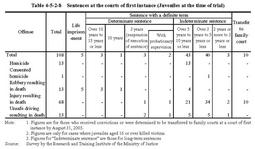| Previous Next Index Image Index Year Selection | |
|
|
2 Criminal trials We will look at trial decisions for serious juvenile offenders aged16or over who were referred to public prosecutors by family court through hearings.The analysis includes juveniles referred back to family courts as a result of district court proceedings.
Among139serious juvenile offenders aged16or over referred to public prosecutors,22were referred to for homicide,one for consented homicide,16for robbery resulting in death,82for injury resulting in death,and18for unsafe driving resulting in death. Among133juvenile offenders who received judgment at a court of first instance by August31,2005,108(81.2%)were juveniles and25(18.8%)were adults at the time of trial. Table4-5-2-8 shows sentences at the courts of first instance,by type of offenses(for juveniles at the time of trial). Five persons(4.6%)were sentenced to life imprisonment,four(3.7%)to imprisonment for determinate sentence of10years or longer,86(79.6%)to imprisonment for indeterminate sentence,three(2.8%)to imprisonment for determinate sentence of three years or shorter with suspension of execution of sentence,and10(9.3%)were transferred to family courts for protective measures and were committed to juvenile training schools by family courts.Among those three juveniles granted suspension of execution of sentence,one committed injury resulting in death(Group Type)in a group lynching case.The juvenile in question was involved in the case dependently,without actually participating in lynching and had taken compensating measures for the bereaved family.The other two committed unsafe driving resulting in death,but the victims were their fellow passengers and the bereaved families'emotional request for a harsh penalty had been eased due to an amicable settlement. Table4-5-2-9 shows sentences at the courts of first instance,by type of offenses(for adults at the time of trial). Three persons(12.0%)were sentenced to life imprisonment,and22(88.0%)to imprisonment with labor for a definite term.Suspension of execution of sentence was not granted to anybody. Table4-5-2-8 Sentences at the courts of first instance(Juveniles at the time of trial) Table4-5-2-9 Sentences at the courts of first instance(Adults at the time of trial) Among10juvenile offenders who were transferred back to family courts for protective measures as a result of district court proceedings and were committed to juvenile training schools from family courts,all committed injury resulting in death(one for one Single Type case and nine for six Group Type cases).Among Group Type cases,seven juveniles were for four cases of group lynching,one for one case of a fight at a pub,and one for one case of violence towards a homeless person.In most Group Type cases,the juveniles in question played a relatively dependent role.Among those ten juveniles,amicable settlements were reached for three(one Single Type juvenile offender and two Group Type juvenile offenders(one for a case of lynching towards playmates and one for a case of violence towards a homeless person))during the district court proceedings.For the other seven juveniles,amicable settlements were not reached but their guardians made efforts toward compensating measures for the bereaved families.District courts seem to have determined protective measures as appropriate,taking into consideration both the bereaved families'emotional request for a harsh penalty and circumstances after hearings.It took four months or more but less than one year from the day when public prosecutors referred these cases to family courts to the day when the final judgments for protective measures were made.The average was about seven months. |

